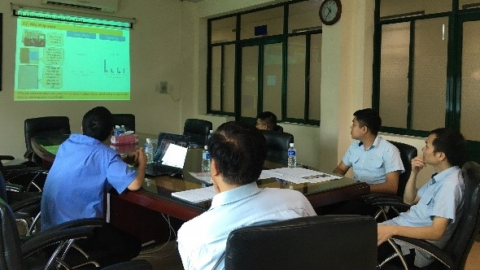
Company employees reporting the results of the Program implementation
Export Mechanical Tools Joint Stock Company was established in 1960 under the Industrial Machinery and Equipment Corporation – Ministry of Industry. In 2001 the company transformed into a joint stock company with 100% of shareholders being officers and employees who have been working in the company. Through more than 50 years of construction and development, the company is always interested in technology improvement, product quality improvement and management system optimization.
In 2020, under the support of the Ministry of Industry and Trade, the Export Mechanical Tools Joint Stock Company (EMTC) has completed the 6-month TPM Program (6-11 / 2020) and has increased overall equipment efficiency index in specialized processing machines by 5%.
|
The implementation of TPM is aimed at maximizing equipment performance, improving productivity with a maintenance system carried out throughout the equipment’s life cycle, and at the same time enhancing worker awareness and job satisfaction. With TPM, everyone can join forces and interact with each other to improve the performance of the device in the most effective way. Think it is my responsibility (equipment operator) to operate the equipment, it is your (maintenance worker) responsibility to repair the equipment, replace it with me and you are both responsible for our equipment, for our factory and our future.. |
With the goal of increasing the overall equipment performance of OEE at the trend production equipment which is specialized processing machine, the EMTC Company and the consulting unit agreed to deploy 2 main pillars of TPM, self-managed maintenance. and the key improvement with the indicator used to evaluate program effectiveness is the OEE. During implementation, the Consultant will provide additional guidance on some planned Maintenance activities to maintain OEE stability.
The OEE index collected from July to November at the specialized machining machine K206 shows that the biggest losses are the stop losses with an average monthly loss of more than 20%. Improvement activities have been carried out to focus on improving this indicator, including rearranging the product flow to reduce the time to take embryo, reducing the time to filter embryo. Knife sharpening time is eliminated by ready preparation of cutters, feres, and drills for each production shift.
For outage problems, the maintenance department conducts a stop analysis to identify the root cause, suggests innovative solutions, and then serves as a reference for similar faults that are likely to occur. error occurs at the same machine in the future. In addition, the repair log, troubleshooting at the machine also started to be applied to calculate MTTR, MTBF index, towards better management of equipment and maintenance personnel. In the long term, the spare parts and spare parts catalog and the overall maintenance plan should be revised to suit the actual condition of the equipment.
For self-managed maintenance, operators at pilot machines were more aware of basic equipment care and early detection of equipment abnormalities. The implementation of 5S and basic machine maintenance such as re-arrangement of electrical wiring, gas lines, tools, semi-finished products, improved chip shielding… helps the machine area to be tidy, more organized, and reduce time. cleaning space for operators.
The integrated application of solutions from basic equipment care, key improvement and equipment maintenance has increased the OEE index of specialized processing machines by 5%, increasing product output on average 60 -70 units. From this result, the company’s leaders plan to expand the implementation of technical contents of TPM to the entire Mechanical Workshop 1 and the whole company in the near future.
Productivity and Quality Office